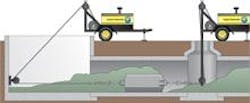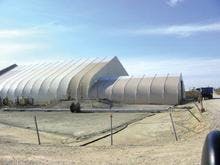Company Safely Cleans Chemical Process Sewer Lines
Almost two years ago, personnel at BP's Chocolate Bayou chemical plant near Alvin, TX, were faced with cleaning over two miles of large-diameter process sewer lines and a large oil-water separator which were about half filled with a thick sludge containing benzene and other hydrocarbons. They needed to recapture the sewer capacity for safety and environmental reasons and to verify the condition of the pipes. However, they did not want any of the volatile organic compounds (VOCs) that were contained in the sludge to escape into the environment as emissions.
Michelle Somera, a BP project engineer, was assigned the duty of coordinating the many BP departments and outside vendors that would be involved in the project. The first step in that direction was to assemble a project team of about a dozen BP specialists who had relevant expertise or experience, and have them create a list of all of the challenges that would have to be overcome to complete the project successfully.
"Without the hydrocarbons in the sludge, it would have been a very ordinary pipe-cleaning job," Somera said. "But, the hazardous chemicals changed the requirements of the project and required extraordinary measures. Every step was to be carefully planned and executed to protect workers' health and the environment, as well as to assure that the project would be completed."
Potential Contractors
Once the challenges had been identified, the team had to identify the best contractor and technology to clean the pipes. To assemble a list of potential contractors, the project team relied upon its own experience and that of employees at other BP chemical plants. This effort, Internet research, and the industry "grapevine" identified several contractors willing to bid on the project.
"There are a lot of contractors who have cleaned sewers, but very few who have cleaned large-diameter sewers in industrial plants," said Phil Johnson, infrastructure resource team supervisor at BP. "Work in chemical plants and refineries has its own unique set of requirements, and contractors either meet those requirements or they don't. So, after talking to all the companies, it was fairly easy to narrow the field to six major players that we felt had the capabilities to do the job."
Each of those six contractors was asked to submit a written proposal outlining the techniques they would use to protect the workers and environment, and the methods they would use to clean the pipes.
"We got a wide range of proposals," Johnson said. "They included everything from mechanical scraping to biological remediation. Not all of the methods were proven technologies, but the proposals allowed us to evaluate a broad range of ideas and reduce the field to three serious contenders.
"We asked those three contractors to put a price on their proposal, and to come in prepared for detailed discussions. At the end of those discussions, the project team felt confident one of the contractors was clearly the right choice for us. The technology wasn't cutting-edge, but it was proven, and so was the contractor."
Winning Technology
"Actually, it took a team of three Carylon companies to meet the challenges of this job," said Mike LaBerge, general manager of Specialized Maintenance Services, Inc. (SMS) Pasadena, TX. "We are a part of the Carylon Corporation, a group of 16 specialty contractors with 28 locations nationwide. When I saw the requirements of this job, I was able to find the exact experience and expertise that was needed from within our corporation."
The plan proposed by the Carylon team called for a 180- by 120- by 50-foot fabric-covered enclosure to be built over the oil-water separator and surrounding work area to capture the volatile emissions. The air inside the enclosure would be continuously monitored and pulled through activated carbon filters before it was released into the atmosphere. Other specific air-quality measurements would be made five times during each of the two work shifts each day.
Workers inside the enclosure would wear full-face respirators most of the time, and the exhausts from all internal-combustion engines would be vented to the outside through flexible stainless steel hoses. The 7 mgd of normal effluent flow carried by the process sewer was rerouted through bypass lines and pumps to the wastewater treatment plant.
"We planned to clean the oil-water separator first, then pull the material from the pipelines into the separator for removal," said Bill Burchell, president of Robinson Pipe Cleaning Co., the Carylon company responsible for engineering the cleaning operation. "We also planned to use scraping machines as the primary means of removing the sludge from the pipelines. This would scrape the sludge out in a semi-solid state and reduce the need for hydrojetting, which would have greatly increased VOC emissions."
Mobile Dredging & Pumping Co., the third Carylon company involved in the project, provided the crew and equipment to dewater the sludge after it was removed from the separator.
Lane Altenbaumer, SMS's project manager, explained that a special chemical was used in all their operations to reduce VOC emissions.
"The chemical encapsulated most of the hydrocarbon molecules and prevented them from becoming airborne," he said. "This provided a safer work environment and captured the hydrocarbons so they could be scrubbed out of the process water in BP's normal wastewater treatment process."
The chemical was used at every step in the sludge removal process from the most remote manhole to the oil-water separator. As each manhole was opened, a spray bar was placed over the opening to apply a three-percent solution of the chemical to suppress emissions. The chemical was added to all water used in jet nozzles, fire hoses, and the mix tanks. Typically, the chemical would reduce hydrocarbon levels from 600 parts per million (ppm) in untreated areas to less than one ppm after treatment.
Cleaning Process
The start date of the cleaning operation was delayed about a month because of difficulty in erecting the tent-like structure during the wettest Texas hurricane season in 50 years.
"The Chocolate Bayou facility is on a tidal flood plain, so moving heavy equipment is practically impossible except on prepared surfaces," said Brian McKnight, Robinson Pipe Cleaning's project superintendent. "BP did a lot of engineering to help us with that. Once we started, the project moved along very well. Some things were more difficult than we had hoped, but we weren't surprised, and we just took care of them as they came up."
A hydraulic pump was suspended from a crane over the oil-water separator to lift the sludge into tanks where it was mixed to a thin milkshake-like consistency. From the mixing tanks, the sludge was pumped into a portable plate-and-frame dewatering device where the water was pressed out, leaving almost-dry "cakes" of the solids.
As the sludge was being removed from the separator tank, another crew strung cable from the separator to the first manhole in the incoming 84-inch sewer pipe. The cable was attached to a scraper which pulled the sludge into the separator tank. This process was extended, manhole by manhole, until most of the pipeline was cleaned. The smallest and most upstream parts of the pipeline were hydro-jetted.
After the pipes were clean, the entire system was examined using remote-controlled explosion-proof video cameras. This verified that the pipes were in good condition and established a benchmark for future comparison.
Conclusion
Working around the clock, it took 56 days to complete the cleaning portion of the project. During that time, 6900 man hours were expended to clean 4500 cubic yards of raw sludge from 6700 linear feet of pipe, ranging from 24 to 84 inches in diameter. The project was completed without a single accident, reportable incident, or even a near miss. As a result, the project was selected as the Chocolate Bayou HSE (Health, Safety, Environmental) Award winner for the first quarter of 2003.



